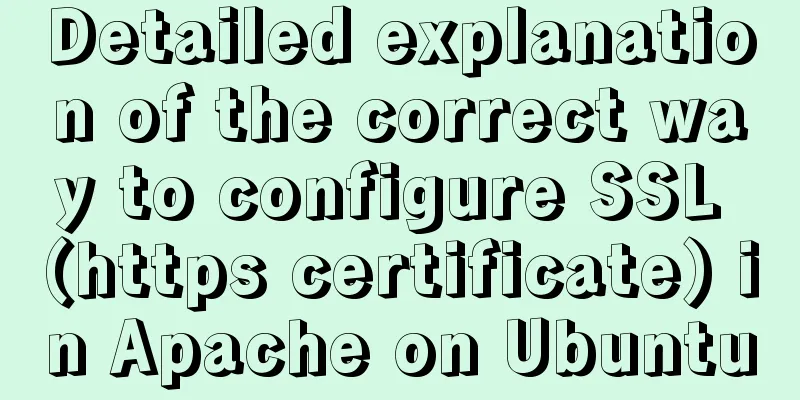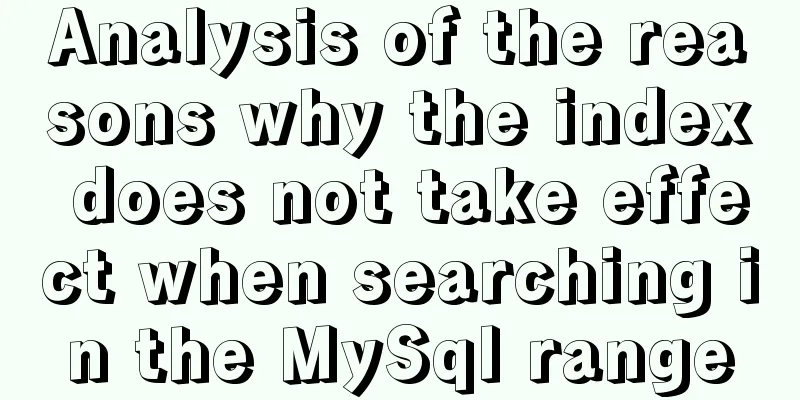Practical tutorial on modifying MySQL character set

Preface:In MySQL, the system supports many character sets, and there are slight differences between different character sets. The most commonly used character sets at present should be utf8 and utf8mb4. Compared with utf8, utf8mb4 supports the storage of emoji expressions and has a wider range of uses. This article will introduce how to change utf8 to utf8mb4 character set. 1. Introduction to utf8 and utf8mb4 character setsCharacter is a general term for various texts and symbols, including national texts, punctuation marks, graphic symbols, numbers, etc. A character set is a collection of multiple characters. Character sets in MySQL can be used at four levels: server level, database level, table level, and column level. The comparison rules at the server level are controlled by the character_set_server parameter. If no character set is explicitly specified when creating a database, table, or column, the character set of the previous level will be inherited. The default character set for MySQL 5.7 and earlier versions is latin1, and the default character set for MySQL 8.0 is utf8mb4. However, using latin1 can easily lead to garbled characters, so utf8 and utf8mb4 are the most widely used. utf8 is actually an alias for utf8mb3, which uses only 1 to 3 bytes to represent characters. utf8mb4 uses 1 to 4 bytes to represent characters, and can store more emoji expressions and any new Unicode characters. utf8mb4 is compatible with utf8 and can represent more characters than utf8. It is a superset of the utf8 character set. Therefore, some new businesses now recommend setting the database character set to utf8mb4, especially when there is a need to store emoticons. 2. Modify the character set methodThe current Internet business has an increasing demand for emoji storage. For example, nicknames and comments must support emojis. At this time, if the database field uses the utf8 character set, the following error will be reported:
To meet business needs, we need to change the database character set to utf8mb4. Fortunately, utf8mb4 is a superset of utf8, so no other conversion is required except changing the encoding to utf8mb4. Here is a brief description of the modification method. System parameter modificationFirst, you should modify the system character set parameters so that the default character set for the database tables created in the future is utf8mb4. Find the configuration file and add or modify the following parameters: vi /etc/my.cnf [mysqld] character-set-server = utf8mb4 collation-server = utf8mb4_general_ci skip-character-set-client-handshake #Ignore the character encoding set by the application connection and keep it consistent with the global setting [client] default-character-set=utf8mb4 [mysql] default-character-set=utf8mb4 Modify the database character setFor a database that has already been created, if the original character set is utf8, you can modify it as follows: # Set the database character set encoding ALTER DATABASE `dbname` CHARACTER SET utf8mb4 COLLATE utf8mb4_general_ci; # Examplemysql> show create database testdb; +----------+-----------------------------------------------------------------+ | Database | Create Database | +----------+-----------------------------------------------------------------+ | testdb | CREATE DATABASE `testdb` /*!40100 DEFAULT CHARACTER SET utf8 */ | +----------+-----------------------------------------------------------------+ 1 row in set (0.00 sec) mysql> alter database `testdb` CHARACTER SET utf8mb4 COLLATE utf8mb4_general_ci; Query OK, 1 row affected (0.01 sec) mysql> show create database testdb; +----------+--------------------------------------------------------------------+ | Database | Create Database | +----------+--------------------------------------------------------------------+ | testdb | CREATE DATABASE `testdb` /*!40100 DEFAULT CHARACTER SET utf8mb4 */ | +----------+--------------------------------------------------------------------+ 1 row in set (0.00 sec) Modify table and field character setSimilarly, for tables that have already been created, changing the global and database character sets will not affect the character sets of the original tables and fields. The original utf8 table can be modified as follows: # Modify the table character set alter table `tb_name` default character set utf8mb4; # Modify the character set of a field alter table `tb_name` modify col_name varchar(20) character set utf8mb4; # Modify the character set of the table and field at the same time alter table `tb_name` CONVERT TO CHARACTER SET utf8mb4 COLLATE utf8mb4_general_ci; # If there are many tables in a database, you can splice the batch modification statements to be executed SELECT CONCAT( 'ALTER TABLE ', TABLE_NAME, ' CONVERT TO CHARACTER SET utf8mb4 COLLATE utf8mb4_general_ci;' ) FROM information_schema.`TABLES` WHERE TABLE_SCHEMA = 'testdb'; 3. Some suggestionsThe modification method seems simple, but you still need to be extra careful in the production environment. In particular, when modifying the field character set, a lock will be added to prevent write operations. This is also very slow for large tables and may affect online business. If your database is relatively small, the above method should not be a problem. For online environments, if you want to modify the character set, you must make a good assessment. It is best to shut down the system for modification during the off-peak period of business, and be sure to back up before modification. If there is no downtime, you can consider making changes in the backup database first and then switching between the primary and backup databases, but this will be more troublesome. If conditions permit, you can also prepare an empty instance, import the table structure first, change it to utf8mb4 character set, and then import the data. This is also a method, but it may also require downtime and switching. The above is the details of how to modify the character set in MySQL. For more information about modifying the character set in MySQL, please pay attention to other related articles on 123WORDPRESS.COM! You may also be interested in:
|
<<: Solve the problem of Nginx returning 404 after configuring proxy_pass
>>: Detailed explanation of the new CSS display:box property
Recommend
Implementing a simple Gobang game with native JavaScript
This article shares the specific code for impleme...
GDB debugging MySQL actual combat source code compilation and installation
Download source code git clone https://github.com...
How to find the IP address of Raspberry Pi when it is connected to the wireless network without a screen
Assuming you are a linuxer , we don't want to...
Detailed explanation of CSS elastic box flex-grow, flex-shrink, flex-basis
The functions of the three attributes flex-grow, ...
Why does MySQL paging become slower and slower when using limit?
Table of contents 1. Test experiment 2. Performan...
C# implements MySQL command line backup and recovery
There are many tools available for backing up MyS...
UCenter Home site adds statistics code
UCenter Home is an SNS website building system rel...
Introduction to possible problems after installing Tomcat
1. Tomcat service is not open Enter localhost:808...
Linux general java program startup script code example
Although the frequency of starting the shell is v...
CSS uses BEM naming convention practice
When you see a class, what information do you wan...
Analysis of the process of configuring Alibaba Cloud proxy warehouse based on Nexus
The default remote repository of Nexus is https:/...
Create a virtual machine and install the Redhat Linux operating system on VMware (graphic tutorial)
How to create a virtual machine on VMware and ins...
Specific steps for Vue browser to return monitoring
Preface When sharing a page, you hope to click th...
Detailed tutorial on how to publish springboot projects through docker plug-in in IDEA
1. Write the Dockerfile (1) Right-click the proje...
How to add color mask to background image in CSS3
Some time ago, during development, I encountered ...









